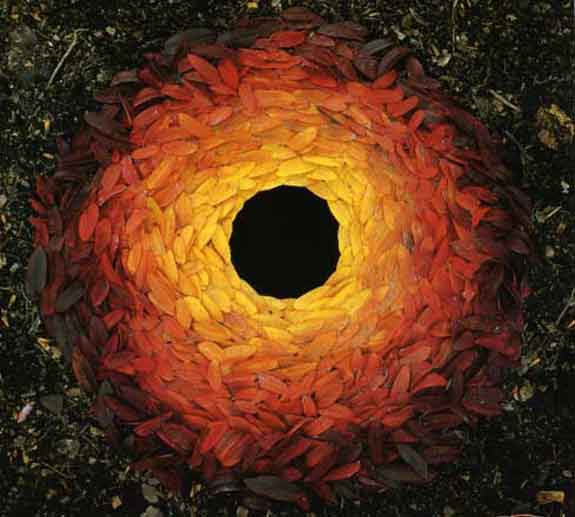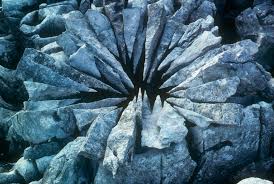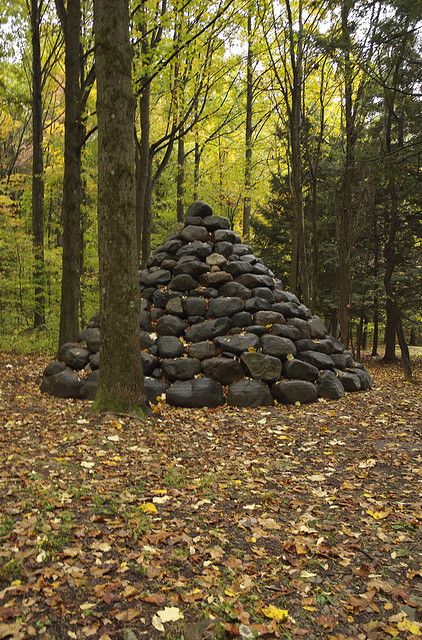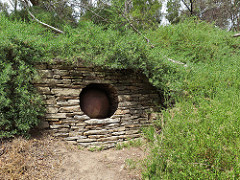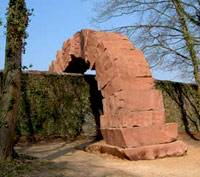I have decided to also consider Andy Goldsworthy in my artists research because while he also doesn’t build dens/homes in the environment he uses his natural surroundings to create structures and patterns. He uses an extreme variety of materials to create his structures from snow to petals to clay. Goldsworthy is considered part of the Environmental Art movement as both a sculptor and a photographer. His work become instillation’s within the environment as they are created for the space in which they are made from elements of the space. Because they are created in such unpredictable locations his work is deliberately ephemeral. I like the concept that he leaves his designs within the environment and allows nature to naturally make them disappear. With many of the dens we made as children out of branches we left them as they were, sometimes even coming back to them a week later as they were natural and therefore would just disappear back into their surroundings. This is the whole point of many of Goldsworthy’s designs that they are fleeting and are only around for a shot period of time. I guess this also links to how with den building you become so absorbed with the process but then you always have to leave them behind in the environment they are in or at least partially dismantle them, taking back all the blankets.
“I enjoy the freedom of just using my hands and “found” tools–a sharp stone, the quill of a feather, thorns. I take the opportunities each day offers: if it is snowing, I work with snow, at leaf-fall it will be with leaves; a blown-over tree becomes a source of twigs and branches. I stop at a place or pick up a material because I feel that there is something to be discovered. Here is where I can learn. “
The main idea behind why Goldsworthy creates his pieces are that he wants to understand nature better by participating with it. He feels closer to nature and as if he can understand it by manipulating it. Goldsworthy talks about how to him the process is as important as the final result which is what i am also considering within my project by photographing the process of the den building. He talks about how he considers the material as important as the final piece as each action of creating his structures are not independent of each other. When he picks up a material to place it somewhere else he is not just considering what he can create with the material itself but the space and influence he creates on the place the material has been moved from. Goldsworthy then finds it significant of how when he makes a change to the environment and then leaves, changes continue to happen because of the first change that he initially made, that nature always carries on. He therefore considers movement to be a key part of his pieces as the piece will change as time moves forward. I think this is really interesting to consider with my natural dens and has given me another idea in photographing them. I could photograph the process of building the den and everything i was previously going to do but then i could keep coming back to the den over a couple of weeks and photographing how it falls apart and once again becomes reverted back to being a part of nature.
“Each work grows, stays, decays. Process and decay are implicit. Transience in my work reflects what I find in nature.”
“Failure is really, really important, but failures have to hurt. … And if I start making this work with the intention of it collapsing, then I’ve lost that intensity of the will for it to succeed, which makes the failure that much more poignant and significant. So there’s a really odd sort of state of mind that I guess I get into when I’m making these works, that is necessary for me to extract the finished piece [and] extract the right kind of feeling for the work as I’m making it. … To achieve what I want, to achieve the works that I make, I have to be fully committed to them succeeding. I couldn’t make them otherwise. And you cannot feel that commitment without feeling or having a deep sense of loss when they do collapse or fail, and that’s inevitable.”
“When I make something, in a field or street, it may vanish but it’s part of the history of those places,” he says in another interview. “In the early days my work was about collapse and decay. Now some of the changes that occur are too beautiful to be described as simply decay. At Folkestone I got up early one morning ahead of an incoming tide and covered a boulder in poppy petals. It was calm and the sea slowly and gently washed away the petals, stripping the boulder and creating splashes of red in the sea. The harbour from which many troops left for war was in the background.”
Above are the most den like structures that Goldsworthy has created that i could find, But after really considering his work the concept of all his pieces really does fit in with the process of den building and even the end product. To summarize all the similarities;
-Firstly they are both created from the materials on hand at the time in the specific location. Goldsworthy will use elements of the environment around him to create his work like when building a den you will use down the beach rocks but then in a wood you would use branches. This then influences the environment you are building in as you are moving things around and creating new things.
-Next the structures are then left behind within the environment and become once more apart of the land. The den structures decay slowly and become once again part of the surroundings much like the work of Goldsworthy in which he creates the structures and then leaves them.
-Both are also all about the process of creation and can be in need of constant repair which makes the whole point of the den being the process and not the final product. When creating dens they constantly fall apart and some of Goldsworthy’s work is never completed as it cant be.
-Another point is that you use the surroundings around you to create the structures, as in with den building there is no official plan or structure which you know you are going to make you consider what you have and what can be achieved with it.
I think by considering Goldsworthy’s work it has made me consider den building in a more in depth way then before. I didn’t realize when i set out to research Goldsworthy’s work that all the concepts for his designs match up so well with den building. I will therefore have to consider them when i create my den.
IMAGE ANALYSIS
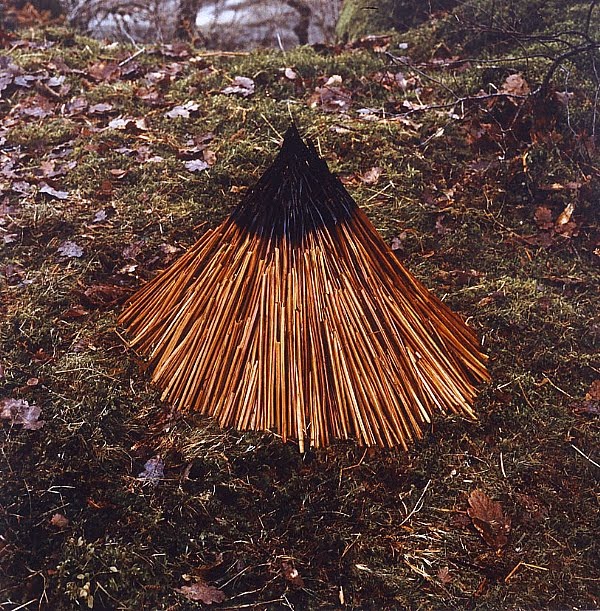
Below is one of my favourite of Goldsworthy’s photographs. I think it will be significant to consider how he photographs his work just as i did with Christo and Jeanne-Claude. His structures are on a lot smaller scale then any of Christo’s work and i am going to be working on a scale in between both artists so it will be good to consider both to find a middle ground. Goldsworthy seems to take photographs of his structures in a very formal and straight photographic manner. I think this is because for him the main element of the photograph is to act as a documentation of the act, as my photographs are going to do. Goldsworthy’s therefore must be considering through out the process of creation where he is creating the piece in the environment and how it would look photographed. The photograph for him however is definitely a secondary element and it is the act of creation which is the point of his work.
The structure below is small which we can tell from the surroundings and the angle of the photograph looking down. I think it is an interesting design in which Goldsworthy has taken sticks which are straight and created a circular structure. It is very reminiscent of tipi’s and seems to rely on the same structural principle that all the sticks weight is placed at the center of the design and by all leaning together they counter balance each other. What makes this structure so interesting is the identical nature of all the sticks. I’m not quite sure what kind of tree or even whether the sticks naturally look as they do in the picture but i would assume they do in reference to Goldsworthy’s concepts. Therefore it has taken Goldsworthy time and skill to find sticks in which the gradient of dark wood to light wood all match up to create a structure with a dark circle in the center. Colour wise the photograph works really well in having the light brown of the sticks bringing out the light brown from the leaves in the surroundings. The lightest point of the photograph is the background of the frame and also the flecks of light colours of leaves scattered across the moss. The darkest point is then the dark ends of the sticks which ties in with the darkness of the moss in places. All the colours with in the photographs are natural and therefore compliment each other . None of the colours in this particular pieces are bold and bright to stand out, they all work together and give the piece an overall appearance. The photograph has been composed so the structure is in the dead center of the frame.
I think it is quite important to consider how the structure has been photographed from the side and not above. By taking the photograph from above the scale of the piece would have been harder to identify and also the texture of the sticks placed together may also have been lost. Also you can consider that the structure may not be a perfect circle, from this angle you can not tell but from above yo would be able to notice tiny details which are slightly out.

